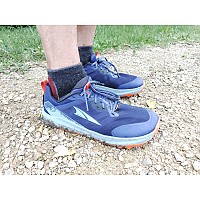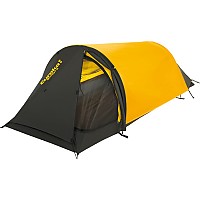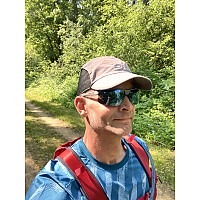Alpina Lite Terrain
The Lite Terrain has been discontinued. If you're looking for something new, check out the best nordic touring skis for 2025.

Alpina ski review
I bought the Alpina Lite Terrain Skis in 2010 for an intended trip on the Sierra Haute Route. This is an ambitious route through the high Sierra with much of it over 11,000 feet and a long (8 mile) approach hike. Usually AT gear is recommended but I wanted a lighter set up and was willing to sacrifice some downhill virtuosity for lightness and climbing ability. We were stormed out in 2010 and went in this year (2011) at the beginning of May.
My background:
I’m 5’9, 190lbs. nearly 60 years old, and have been skiing and climbing in the backcountry since 1970 or so. I’ve had a zillion different skis from wood alpine skis we cut down narrow on a table saw and put 3 pin bindings on in the early 70’s, to Silveretta Cables on downhill skis, metal edged BC with little sidecut, AT gear, lite XC stuff, and various Alpine set ups. I’ve climbed in various places around the world and still consider the Sierras a perfect string of mountains.
In the year I’ve owned them I skied groomers, did some laps at Castle Lake (near Mount Shasta) and on Mount Shasta. I just finished a 6 day trip on the Sierra Haute Route (SHR) and they were a great ski for the trip.
The Skis:
The Alpina Lite Terrain is a waxless ski with single camber, 178cm, 102-64-87, 4lbs. 12oz. They retail for about $250 and I think I paid $210. Pretty cheap price relatively speaking. I mounted them with Voile Cable bindings (29 oz.) and Garmont Excursion boots.
Overall I am VERY pleased with this set up.
Uphill Performance:
These have an aggressive fish scale pattern on the base. They climb really well. For something with a lot of ups and downs where skins are going to come on and off too often these shine. For a sustained climb of maybe 20 degrees and steeper I skinned up – especially with a pack on. But in rollers they are fun. The waxless base allowed us to choose our route indiscriminately. We didn’t need to worry about needing to get up a small ridge or hump.
Downhill performance:
Tele at the lifts – the skis are very responsive. They come around right away and hold the turn without requiring a lot of effort and don’t seem to care how steep it is. I skied black diamonds, tree chutes and everything else on them. They perform very consistently. They do not like speed. If you want to run tele laps or break the sound barrier these are not for you but if you want to tour and get some fun turns – and the Sierra Haute Route is definitely not a golf course tour – then you might like these skis. They are slow. Really slow. The fish scales drag like crazy – this is in comparison to AT or Tele skis with no base pattern.
In the backcountry I never noticed the drag on the downhills though a smooth base ski would certainly glide much easier and further. It has a good balance between downhill performance and climbing ability. It’s better at climbing or basic touring stride than aggressive downhilling. Skiing with a winter pack I’m not able to ski aggressively anyway which was another reason to choose this lighter ski. It is a fun ski to turn though.
Shortcomings:
It doesn’t float well. If the snow is much over 6” deep it doesn’t just pop up on top. The skis are short – 178 is the longest they make. From me, who knows little about ski design, they might be better served to have a slightly more upturned and longer tip.
The first day I used them I was trying some old Asolo Snowfield leather boot s on them up at Castle lake. (The SHR has a long dry hike in and I was trying to decide if I could use the Asolos for both skiing and hiking.) It was a great soft snow day, no rocks etc. The Asolos definitely could not drive the ski, at least they couldn’t on my feet. I fell several times, not big screaming falls but falls from being too far back on the ski. At the end of the first day there was a big chunk out of one ski. This was the first day I’d used these skis. I can't figure out how to put photos in here or I'd show you the damage.
Not only was I bummed out but I wondered if durability was an issue and how the heck would they survive the high sierra if a little fall would break them. I called Akers ski, where I bought them online and clear across the country. They were no help and suggested I call Alpina. Alpina never responded. I can't figure out how to put photos in here or I'd show you how I patched them.
It was with a flexible epoxy.
The lesson may be – purchase from someone who has to look you in the eye if something goes wrong with your ski.
Despite this bummer the patch held up. The skis are unscathed despite being carried on my pack with the requisite tails hitting the ground while laying the pack down during rests etc. So, despite my problem with them and lack of company response they seem to be durable.
AT ski set ups are typically recommended for the SHR. I think they are too heavy unless you are really strong for skiing with a pack on and/or have energy left over at the end of a day to go earn some turns. We played a whole day with no packs in the Milestone Creek drainage and dropping into Kern Canyon – definitely tons of fun.
Skiing down from below Shepherds pass I dropped a couple thousand vertical feet with a pack on and had a really good descent except for one place where the corn was 8”+ deep and thick – I didn’t have enough power and speed to drive through it.
The Alpina Lites were pushed into the edges of true Alpine Touring and I think they performed very well.
Price Paid: $210
For a lightweight, high mountain setup this bridges the gap between off-track ski touring and AT setups. Great for spring high mountain touring.
Pros
- Light eight
- Climbs well
- Turns well
Cons
- Slow
Alpina ski review:
I bought the Alpina Lite Terrain Skis in 2010 for an intended trip on the Sierra Haute Route. This is an ambitious route through the high Sierra with much of it over 11,000 feet, several 13,000' passes, and a long (8 mile) approach hike. Usually AT gear is recommended but I wanted a lighter set up and was willing to sacrifice some downhill virtuosity for lightness and climbing ability. We were stormed out in 2010 and went in (2011) at the beginning of May.
My background:
I’m 5'9", 190 lbs. nearly 60 years old, and have been skiing and climbing in the backcountry since 1970. I’ve had a zillion different skis from wood alpine skis we cut down narrow on a table saw and put 3 pin bindings on in the early '70s, to Silveretta Cables on downhill skis, metal edged BC with little sidecut, Ramers, Silveretta 404 on Tuas, modern AT gear, lite XC stuff, and various Alpine set ups. I’ve climbed in various places around the world and still consider the Sierras a perfect string of mountains.
In the year I’ve owned them I skied groomers, did some laps at Castle Lake (near Mount Shasta with 30-35 degree slopes) and on Mount Shasta. I just finished a 6-day trip on the Sierra Haute Route (SHR) and they were a great ski for the trip.
The Skis:
The Alpina Lite Terrain is a waxless ski with single camber, 178cm, 102-64-87, 4lbs. 12oz. They retail for about $250 and I think I paid $210. Pretty cheap price relatively speaking. I mounted them with Voile Cable bindings (29 oz.) and Garmont Excursion boots.
Overall I am VERY pleased with this set up.
Uphill Performance:
These have an aggressive fish scale pattern on the base. They climb really well in spring Sierra snow. For something with a lot of ups and downs where skins are going to come on and off too often these shine. For a sustained climb of maybe over 25 degrees I skinned up – especially with a pack on. But in rollers they are fun. The waxless base allowed us to choose our route indiscriminately. We didn’t need to worry about picking our way up a small ridge or hump.
Downhill performance:
Tele at the lifts – the skis are surprisingly responsive. They come around right away and hold the turn without requiring a lot of effort and don’t seem to care how steep it is. I skied black diamonds, tree chutes and everything else on them. They perform very consistently.
They do not like speed. If you want to run tele laps or break the sound barrier these are not for you but if you want to tour and get some fun turns as opposed to climbing things FOR the downhill run – and the Sierra Haute Route is definitely not a golf course tour – then you might like these skis. They are slow. Really slow. The fish scales drag like crazy – this is in comparison to AT or Tele skis with no base pattern.
In the backcountry I never noticed the drag on the downhills though a smooth base ski would certainly glide much easier and further. It has a good balance between downhill performance and climbing ability. It’s better at climbing or basic touring stride than aggressive downhilling. Skiing with a snow camping pack I’m not able to ski aggressively anyway which was another reason to choose this lighter ski. It is a fun ski to turn though.
Shortcomings:
It doesn’t float well. If the snow is much over 6" deep it doesn’t just pop up on top when you are striding. The skis are short – 178 is the longest they make. From me, who knows little about ski design, they might be better served to have a slightly more upturned and longer tip.
The first day I used them I was trying some old Asolo Snowfield leather boots on them up at Castle Lake. It was a great soft snow day, no rocks etc. The Asolos definitely could not drive the ski, at least they couldn’t on my feet. I fell several times, not big screaming falls but falls from being too far back on the ski. The Garmont Excursions were a good choice on this ski for heavier than normal mountain touring.
The skis are unscathed despite being carried on my pack with the requisite tails hitting the ground while laying the pack down during rests etc.
AT ski set ups are typically recommended for the SHR. I think they are too heavy unless you are really strong for skiing with a pack on and/or have energy left over at the end of a day to go earn some turns. We played a whole day with no packs in the Milestone Creek drainage and dropping into Kern Canyon – definitely tons of fun.
Skiing down from below Shepherds Pass I dropped a couple thousand vertical feet with a pack on and had a really good descent except for one place where the corn was 8"+ deep and thick – I didn’t have enough power and speed to drive through it.
These are not a ski for powder either. I haven't tried them on real ice — only hard snow at the groomers where they were adequate for my purposes — a strong touring ski with some fun downhill characteristics.
The Alpina Lites were pushed into the edges of true Alpine Touring and I think they performed very well.
Source: bought it new
Price Paid: $210
Your Review
You May Like
Specs
| Price |
Historic Range: $191.96-$269.95 Reviewers Paid: $210.00 |






